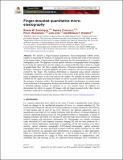Files in this item
Finger-mounted quantitative micro-elastography
Item metadata
| dc.contributor.author | Sanderson, Rowan W. | |
| dc.contributor.author | Curatolo, Andrea | |
| dc.contributor.author | Wijesinghe, Philip | |
| dc.contributor.author | Chin, Lixin | |
| dc.contributor.author | Kennedy, Brendan F. | |
| dc.date.accessioned | 2019-04-11T15:30:01Z | |
| dc.date.available | 2019-04-11T15:30:01Z | |
| dc.date.issued | 2019-04-01 | |
| dc.identifier | 258564406 | |
| dc.identifier | eac388f1-4e37-4d79-a589-8d53d6be83f3 | |
| dc.identifier | 000462887400018 | |
| dc.identifier | 85064442205 | |
| dc.identifier | 000462887400018 | |
| dc.identifier.citation | Sanderson , R W , Curatolo , A , Wijesinghe , P , Chin , L & Kennedy , B F 2019 , ' Finger-mounted quantitative micro-elastography ' , Biomedical Optics Express , vol. 10 , no. 4 , pp. 1760-1773 . https://doi.org/10.1364/BOE.10.001760 | en |
| dc.identifier.issn | 2156-7085 | |
| dc.identifier.other | ORCID: /0000-0002-8378-7261/work/56424287 | |
| dc.identifier.uri | https://hdl.handle.net/10023/17504 | |
| dc.description | Funding: Australian Research Council (ARC); the Cancer Council, Western Australia; OncoRes Medical; War Widows' Guild of Western Australia Scholarship. | en |
| dc.description.abstract | We present a finger-mounted quantitative micro-elastography (QME) probe, capable of measuring the elasticity of biological tissue in a format that avails of the dexterity of the human finger. Finger-mounted QME represents the first demonstration of a wearable elastography probe. The approach realizes optical coherence tomography-based elastography by focusing the optical beam into the sample via a single-mode fiber that is fused to a length of graded-index fiber. The fiber is rigidly affixed to a 3D-printed thimble that is mounted on the finger. Analogous to manual palpation, the probe compresses the tissue through the force exerted by the finger. The resulting deformation is measured using optical coherence tomography. Elasticity is estimated as the ratio of local stress at the sample surface, measured using a compliant layer, to the local strain in the sample. We describe the probe fabrication method and the signal processing developed to achieve accurate elasticity measurements in the presence of motion artifact. We demonstrate the probe's performance in motion-mode scans performed on homogeneous, bi-layer and inclusion phantoms and its ability to measure a thermally-induced increase in elasticity in ex vivo muscle tissue. In addition, we demonstrate the ability to acquire 2D images with the finger-mounted probe where lateral scanning is achieved by swiping the probe across the sample surface | |
| dc.format.extent | 14 | |
| dc.format.extent | 6955625 | |
| dc.language.iso | eng | |
| dc.relation.ispartof | Biomedical Optics Express | en |
| dc.subject | QC Physics | en |
| dc.subject | R Medicine (General) | en |
| dc.subject | T Technology (General) | en |
| dc.subject | NDAS | en |
| dc.subject.lcc | QC | en |
| dc.subject.lcc | R1 | en |
| dc.subject.lcc | T1 | en |
| dc.title | Finger-mounted quantitative micro-elastography | en |
| dc.type | Journal article | en |
| dc.contributor.institution | University of St Andrews. School of Physics and Astronomy | en |
| dc.identifier.doi | https://doi.org/10.1364/BOE.10.001760 | |
| dc.description.status | Peer reviewed | en |
This item appears in the following Collection(s)
Items in the St Andrews Research Repository are protected by copyright, with all rights reserved, unless otherwise indicated.

